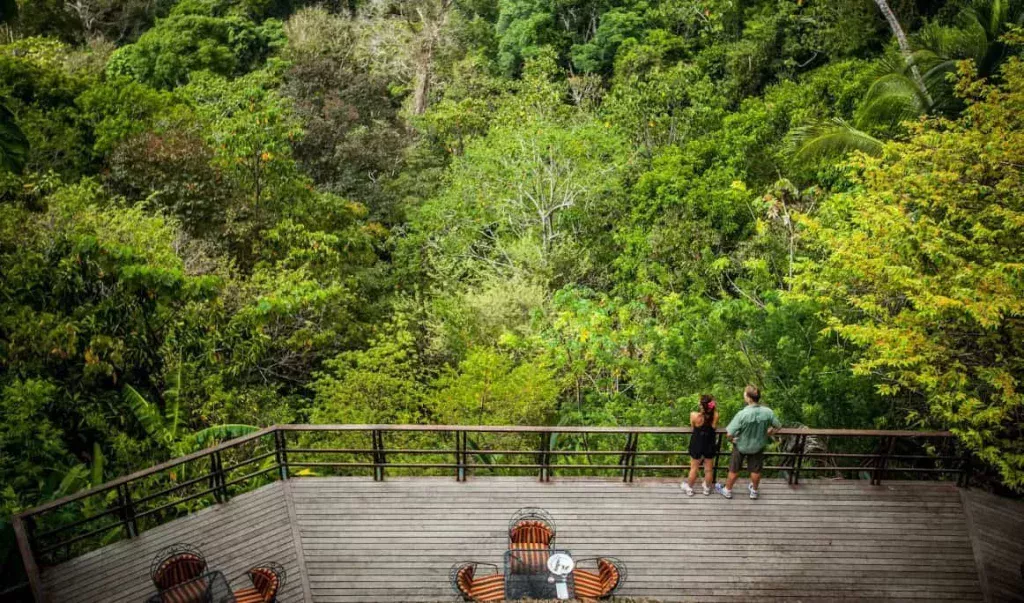Sustainable tourism has evolved from a niche movement into a global trend, reflecting heightened awareness of responsibilities toward the environment and communities. With climate change becoming an urgent issue and the tourism industry significantly contributing to carbon emissions, the demand for responsible tourism has grown critical. The year 2025 marks a turning point, as trends not only focus on reducing negative impacts but also on creating positive value for nature and people. The global sustainable tourism market is projected to reach USD 11.53 trillion by 2033, indicating a fundamental shift in how the world is explored. This article analyzes seven trends shaping sustainable tourism in 2025: carbon-neutral tourism, ecotourism, digital detox, regenerative tourism, local experiences, quietcations, and flight-free travel.

1. Carbon-Neutral and Carbon-Negative Tourism
In 2025, carbon-neutral and carbon-negative tourism gain significant traction as the tourism industry is estimated to emit 6.5 billion tons of carbon. Carbon-neutral tourism offsets emissions through tree planting or renewable energy, while carbon-negative tourism removes more carbon than it emits, such as through ecosystem restoration. Airlines and hotels offer carbon offset tickets and resorts powered by solar energy, enabling travelers to reduce their carbon footprint and transform tourism into a tool to combat climate change.
2. Ecotourism and Nature-Based Experiences
Ecotourism takes center stage in 2025, fulfilling the desire to connect with nature. Trips to pristine forests, wildlife reserves, or protected marine areas offer profound experiences while supporting conservation and, crucially, creating jobs and delivering economic and environmental benefits to local communities. By combining environmental protection with community development, ecotourism serves as an ideal model for the sustainability of natural destinations.
3. Digital Detox and Wellness Tourism
In a world dominated by technology, digital detox and wellness tourism stand out in 2025. Travelers seek retreats, meditation, and yoga sessions in nature to disconnect and recharge. These experiences improve mental health, reduce energy consumption from devices, and align with sustainable principles, offering peaceful spaces and promoting healthier lifestyles.
4. Regenerative Tourism
Regenerative tourism represents a significant leap forward in sustainable tourism, expected to strongly shape the industry in 2025. Unlike merely minimizing negative impacts, regenerative tourism aims to repair and restore ecosystems and local communities. Travelers participate in tree planting, biodiversity conservation, and sustainable agriculture support. For instance, in degraded areas, they help restore landscapes, improving both the environment and local economies. This trend fosters a symbiotic relationship between humans and nature, enhancing travelers’ responsibility.
5. Local Experiences
The year 2025 sees a clear shift toward authentic local experiences, a key trend in sustainable tourism. Travelers prioritize genuine interactions with local communities through festivals, handicrafts, and cuisine, exploring “hidden gems.” This generates income, preserves culture, and reduces pressure on overcrowded destinations. Tour operators offer culturally rich tours, promoting sustainable socioeconomic development in lesser-known areas.
6. Quietcations
“Quietcations” surge in 2025, helping travelers escape modern stress. Staying at serene resorts, walking in nature, or reading by a lake gain popularity. This trend minimizes environmental impact by reducing noisy transportation and energy consumption while rejuvenating people and protecting nature. By providing spaces to recharge and connect with nature, quietcations contribute to sustainable goals for human well-being and environmental preservation.
7. Flight-Free Tourism
Flight-free tourism becomes widespread in 2025 as awareness of aviation’s environmental impact grows. Travelers opt for trains, buses, or boats to reduce carbon emissions. This trend not only lowers the carbon intensity of tourism but also encourages exploration of closer, often overlooked destinations. Destination marketers are promoting eco-friendly routes, such as scenic train journeys through mountains or ferry trips to small islands. Flight-free tourism is not only a green solution but also offers a slower, more immersive travel experience.
These trends are not merely theoretical but are being realized through specific projects worldwide. In Vietnam, the “Swiss Tourism for Sustainable Development in Vietnam” project (ST4SD, 2024–2027), funded by the Swiss Government through the Swiss State Secretariat for Economic Affairs (SECO), focuses on carbon-neutral solutions, local experiences, and ecotourism in Hà Giang, Quảng Nam, and Đồng Tháp provinces. The project supports policy development, workforce training, and sustainability enhancement, aligning with Vietnam’s Tourism Strategy 2030. This serves as evidence that sustainable tourism in 2025 not only mitigates negative impacts but also regenerates resources and communities, contributing to planetary protection.